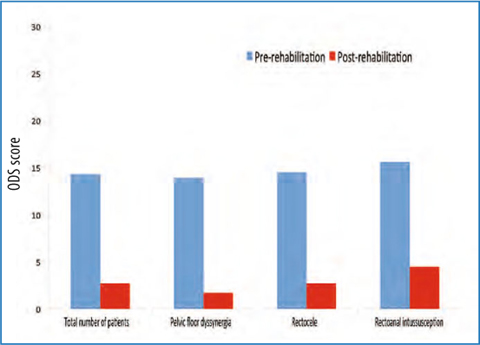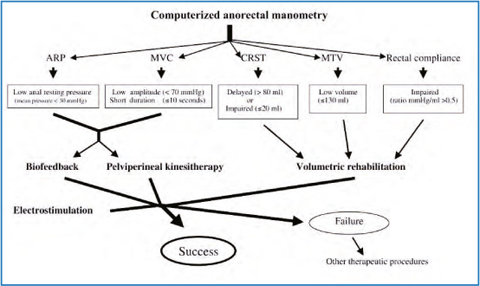Fig. 13.1
Algorithm of multimodal rehabilitation. CRST, conscious rectal sensitivity threshold; MVC, maximal voluntary contraction [4]
Each rehabilitative technique is chosen according to a specific manometric sign, and the techniques may be associated with each other in the following sequence of procedures: (1) volumetric rehabilitation; (2) anal electrostimulation, if necessary; (3) pelviperineal kinesitherapy; and (4) biofeedback.
13.2.1 Volumetric Rehabilitation
Volumetric rehabilitation (sensory retraining) is indicated for disordered rectal sensation and/or impaired rectal compliance. The aim is to increase the patient’s ability to perceive the rectal distension induced by feces or flatus (“rectal sensation”) and to improve the elastic properties of rectal wall. Volumetric rehabilitation involves twice daily administration of a tepid water enema. If the resting conscious threshold for stools is high, the initial volume is equal to the maximally tolerated manometric volume. The patient holds the liquid for 1 min. In the following days, the enema volume (20 mL) is gradually decreased until the patient achieves a normal value of rectal sensation.
13.2.2 Anal Electrostimulation
The purpose of anal electrical stimulation is to induce muscle contraction by direct stimulation or indirectly via peripheral nerve stimulation, but there is no objective effect on anal sphincter pressure. How electrostimulation works on anal function has not yet been defined, but the main possible benefit is improved anal and perineal awareness [5]. For this reason, the use of anal electrostimulation in patients affected by obstructed defecation is limited only to those patients who need a better feeling of anal and/or perineal plane, such as in those with descending perineum syndrome and pelvic organ prolapse. The rehabilitation cycle is performed daily for 3 months by the patient in a home environment. The device delivers a square wave of current alternating between a 5–6 s work period and a 10–12 s rest period, according to a standard sequence of pulse (width in milliseconds, frequency in Hertz).
13.2.3 Pelviperineal Kinesitherapy
This is a type of muscular training that is selectively aimed at the levator ani muscles by improving performance, extension, and elasticity. It is mainly used when there is pelvic floor dyssynergia because it is a specific muscular re-education technique for the uncoordinated pelvic floor muscles [6]. A cycle of pelviperineal kinesitherapy following a standard sequence of exercises is performed twice weekly in ten outpatient sessions, according to a previously published scheme [6]. Briefly, the sequence carries the patient from a preliminary lesson on relaxed breathing and corporeal consciousness through intermediate steps (anteversion and retroversion pelvic movements, puborectalis stretch reflexes) to the final lessons, which include abdominopelvic synergy and anal contraction exercises (i.e., bending down, coughing, and Valsalva’s maneuver in supine, upright, and sitting positions).
13.2.4 Biofeedback
Biofeedback therapy is an operant conditioning [7] that consists of pelvic floor strengthening exercises together with visual/verbal feedback training [8]. It is voluntary, employs a trial-and-error process by which learning takes place, and the subject must be aware of the desired response (signals). During their first training session, patients receive instruction on how to contract and relax the external anal sphincter and puborectalis muscle, and how to improve their strength by using modified Kegel exercises. The number of sessions is customized for each patient and is performed at home using portable devices, twice per day for 20 min. The sessions last for 1 month [6].
Multimodal rehabilitation may be applied to both functional and organic anorectal diseases that cause obstructed defecation.
The results of rehabilitation cycles are reported in Fig. 13.2. The overall obstructed defecation syndrome (ODS) score shows significant improvement after rehabilitative treatment (p < 0.001), and is obtained independently of the causes. Pelvic floor dyssynergia, rectocele, and rectoanal intussusception all have a significantly better post-rehabilitative ODS score (p < 0.001), but pelvic floor dyssynergia has better results than rectoanal intussusception (p < 0.038). Some patients (20.5%) may become symptom-free, meaning that some symptoms or signs of obstructed defecation might persist after rehabilitation. Only 12.8% of patients have poor results and continue with medical treatment involving laxatives and.or enemas: in these cases, obstructed defecation could be the consequence of severe structural lesions. Nevertheless, even if it is difficult to discriminate between patients who will derive some benefit from rehabilitation and those who instead will require surgery, the generally accepted procedure is to begin with rehabilitation treatment [9] and, if this proves ineffective, to then consider surgery [10]. Anal relaxation during attempted defecation, duration of maximal voluntary contraction, and rectal sensation are the main anorectal functions that are positively modified by rehabilitation [1, 4]. There is no general agreement as to what factors may predict or influence the outcomes of rehabilitative treatment. In a recent study, straining and prolonged balloon expulsion independently predicted a positive outcome [11]. Nevertheless, significant anatomical damage, severe psychiatric or neurological disease, poor patient compliance, and poor patient.physiotherapist interactions could pose major obstacles to the success of rehabilitation [12].
13.3 Rehabilitative Treatment of Fecal Incontinence
Fecal incontinence is defined as loss of voluntary control of the passage of stool and/or flatus [13]. The pathophysiology of fecal incontinence is often multifactorial and this fundamental aspect should influence whatever treatment may be proposed. Each patient has his/her own specific pathogenic profile as a result of a mix of etiological factors: for example, 48% of patients with anal sphincter lesions may have impairment of rectal sensation [14]. Each patient thus requires a clinical approach that must be modulated according to his or her specific etiology. This basic fact must be considered when planning therapy for a patient with fecal incontinence and thus rehabilitative treatment should adhere to this statement. Different training programs must be used for different patients and distinct rehabilitation techniques should be employed only when indicated by related diagnostic reports.
The specialized management of fecal incontinence is based on diagnostic data acquired through endoanal ultrasound. The algorithm of management suggests rehabilitative treatment in incontinent patients only when normal anal sphincter anatomy or isolated anal sphincter defect < 120° is detected [14, 15]. Biofeedback and exercises may be considered as the first-line therapeutic option for many patients with fecal incontinence that has not responded to simple dietary advice and/or medication to normalize fecal consistency [16]. There are no international agreements on the use of the various rehabilitative techniques for the treatment of fecal incontinence, and the main problems are related to an absence of universally accepted standards and guidelines. It is thus difficult to propose a single model of rehabilitation because it will always result in being one-sided and incomplete. The rehabilitative techniques that may be used for treating fecal incontinence include biofeedback, pelviperineal kinesitherapy, volumetric rehabilitation (sensory retraining), and anal electrostimulation. The principles of single technique functioning are the same as those described above (see Section 13.2). Biofeedback is the main technique that should be used: it is superior to pelvic floor exercises [17], but when biofeedback is combined with anal electrostimulation the results are better than biofeedback alone [18]. These two statements partially support the hypothesis that several rehabilitative techniques work on different targets and therefore it is self-evident that the techniques must be used one by one or in combination with each other only in some selective cases. For this reason the model of multimodal rehabilitation, performed under the guidance of anorectal manometry, might be a useful option to treat fecal incontinence [19]. The algorithm for multimodal rehabilitation is shown in Fig. 13.3.









